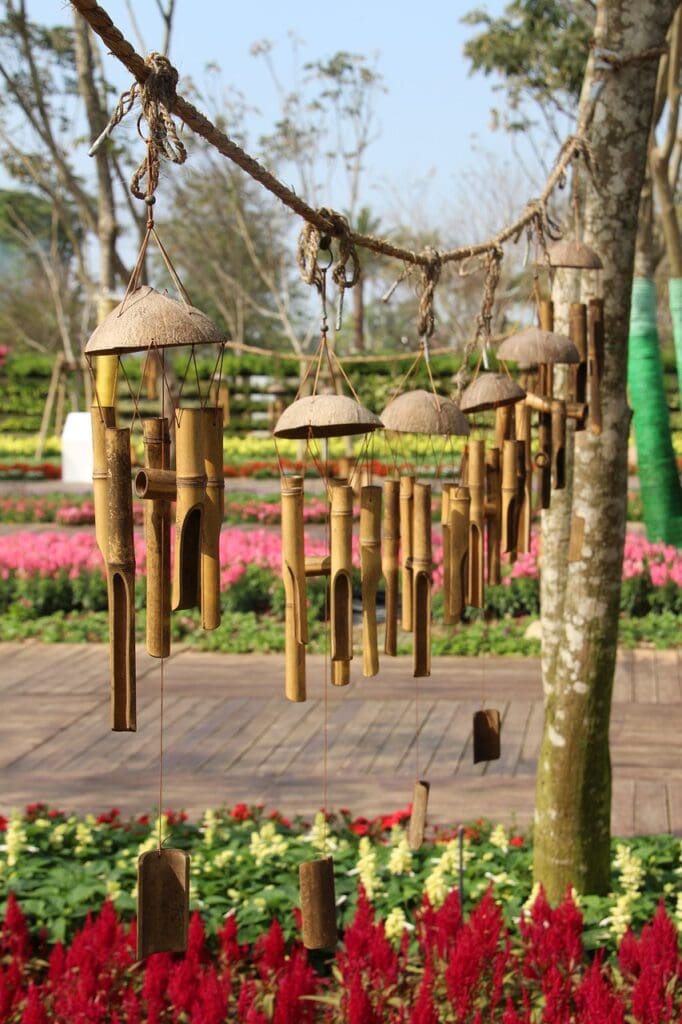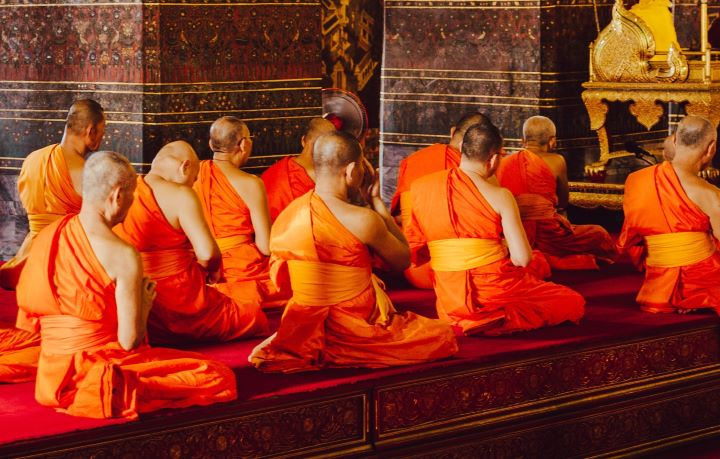Introduction
Bamboo wind chimes are musical instruments that produce soothing tones when the wind blows through them. They are made using natural bamboo tubes of different sizes, each cut to a specific length to produce a unique sound.
Although they are now mostly used for decoration and relaxation purposes, bamboo wind chimes have a rich history and cultural significance in various parts of the world. This article will explore the history, construction, cultural significance, and uses of bamboo wind chimes.
Definition of Bamboo Wind Chimes
Bamboo wind chimes consist of several natural bamboo tubes suspended from a central cord or frame. Each tube is cut to a precise length to create a different pitch when struck by the wind or another object. The tubes may also be adorned with additional natural materials such as shells or stones to enhance their aesthetics.
Brief History of Bamboo Wind Chimes
The use of wind chimes dates back at least 5000 years in ancient China where they were hung outside homes and temples for protection against evil spirits. Around 1100 B.C.E., Japanese gardens began using wind bells made from metal alloys that were hung outside living spaces for their calming sounds.

In India, Ayurvedic medicine practitioners have long used sound therapy with bells as an aid for healing. Wind chimes became popular in Western culture during the 1800s, although they were typically made from metals rather than bamboo.
Importance of Bamboo Wind Chimes in Different Cultures
Bamboo wind chimes hold significant cultural importance in many parts of Asia, including China, Japan, India, and Indonesia. In Chinese culture, they are believed to bring good luck into homes while keeping away negative energy.
Japanese culture views them as symbols of good fortune and peace. In Hinduism, the bells are used in religious ceremonies to purify the air and create a positive atmosphere.



Indonesians believe that the wind chimes bring spiritual protection to homes, while in Bali they are viewed as a symbol of harmony and balance. In the West, bamboo wind chimes have become popular for their aesthetic appeal and relaxing sounds.
History of Bamboo Wind Chimes
Origin and Evolution of Bamboo Wind Chimes
Bamboo wind chimes have been around for centuries, with roots traced back to ancient China. The earliest versions of bamboo wind chimes were made from hollow bamboo stalks and hung from the eaves of houses to scare away birds and evil spirits. Over time, the design and construction techniques evolved, resulting in a variety of sizes, shapes, and sounds.
Use of Bamboo Wind Chimes in Ancient Times
In ancient China, bamboo wind chimes were used not only for their practical purposes but also as a form of art. They were often adorned with intricate carvings or painted designs that reflected the culture’s artistic style. Additionally, some Chinese dynasties used bamboo wind chimes as musical instruments during their performances.
In Japan, bamboo wind chimes are known as “furin” and played an essential role in traditional tea ceremonies. During these ceremonies, the sound produced by the furin was believed to help create a calming atmosphere by drowning out unwanted noises.
Significance and Symbolism of Bamboo Wind Chimes in Different Cultures
Different cultures have unique beliefs about the symbolism and significance of bamboo wind chimes. In Feng Shui principles, they are believed to promote good luck by directing positive energy or “chi” into one’s home or garden.
In some Buddhist traditions, the sound produced by bamboo wind chime represents peace and tranquility. As such they are often used during meditation practices or placed in temples or shrines.
Furthermore, Native American cultures believe that the sound produced by the natural elements such as rain or wind is vital for spiritual healing since it clears negative energies created by human activities. It is therefore common to find them hanging outside homes or other ceremonial places made from natural materials such as bamboo, wood or seashells.
Bamboo wind chimes are not only beautiful pieces of art but also have deep cultural and historical significance across different cultures. Understanding the evolution, use and symbolism of these musical instruments can help us appreciate their value as a form of art, a tool for meditation or healing, or simply as an enjoyable addition to our outdoor living spaces.
Construction and Design of Bamboo Wind Chimes
Materials used to make bamboo wind chimes
Bamboo wind chimes are typically made from bamboo tubes of varying lengths and diameters, each producing a distinct sound. The quality of the bamboo used is crucial to the sound produced by the wind chime.



The best quality bamboo is harvested during the dry season, when it is most durable. The tubes are then cut to the desired length and treated with fire to prevent decay.
In addition to bamboo, other materials such as wood, metal, glass beads, and shells can be used in the construction of a wind chime. These materials can add visual interest as well as contribute to the overall sound of the chime.
Different types and sizes of bamboo wind chimes
Bamboo wind chimes come in a variety of types and sizes. Small handheld versions can be carried around for personal use, while larger ones can be placed on porches or gardens for decoration purposes.



The size and length of each tube determines the pitch produced by the wind chime. Longer tubes produce lower pitches, while shorter ones create higher pitches.
Some designs include several tiers or layers with varying lengths of tubing for more complex sounds. Additionally, some manufacturers offer customizable options where customers have control over both size and type of material used in construction.
Techniques used to create unique sounds from the bamboo tubes
Creating unique sounds from bamboo tubes requires specific techniques during construction. One technique involves cutting notches into each tube at specific points along its length so that when struck by another object (such as another tube), it produces a distinctive tone or melody.
Another technique involves shaving off thin layers from inside each tube until it reaches an optimal thickness that resonates at a desired frequency. Some manufacturers use different materials such as metal rods or beads to suspend the bamboo tubes, which can create additional harmonics and overtones when struck by the wind.
Bamboo wind chimes are not only beautiful decorative pieces, but also produce soothing sounds that can be used for relaxation and meditation. The construction and design of each chime is crucial to its sound quality, making it important for consumers to consider these factors when purchasing one.
Cultural Significance and Beliefs Associated with Bamboo Wind Chimes
Feng Shui principles associated with the use of bamboo wind chimes
Feng Shui is an ancient Chinese practice that involves arranging things in a way that promotes energy flow, balance and harmony. Bamboo wind chimes are believed to have a significant impact on the Feng Shui of a space. According to Feng Shui principles, hanging bamboo wind chimes in specific areas of your house can attract positive energy and change the dynamics of the environment.
Spiritual beliefs associated with the sound produced by bamboo wind chime
The sound produced by bamboo wind chimes is not just pleasing to the ear but also has spiritual significance in many cultures around the world. It is believed that these sounds can cleanse negative energy from a person or space, helping individuals achieve greater peace and tranquility.
Use in religious ceremonies, rituals, and festivals



Bamboo wind chimes have been used for centuries in religious ceremonies, rituals, and festivals across different countries. In some cultures, they are considered sacred objects that ward off evil spirits or call upon good luck and positivity.
Popular Uses for Bamboo Wind Chime Today
Decorative purposes for homes, gardens, patios, etc.
Bamboo wind chimes are widely used for decorative purposes today. They add charm to homes or gardens with their delicate designs and soothing melodious sounds. They come in various shapes such as natural bamboo tubes or fashioned into animals such as elephants or birds.
Relaxation therapy through soothing sounds produced by the wind chime.
The gentle tinkling sound created by bamboo wind chimes has therapeutic properties that can help you relax after a long day at work or even reduce anxiety levels. Studies suggest that the sound produced from wind chimes has a calming effect and can help individuals fall asleep faster.
Meditation practices that incorporate the use of sound.
Bamboo wind chimes are used in meditation practices to enhance focus and mindfulness. The harmonious sounds produced by them create a serene atmosphere that helps you dive deep into your meditation practice, reach a state of relaxation, and connect with your inner self.
Conclusion
Bamboo wind chimes have been significant in different cultures throughout history and continue to be today for their aesthetic appeal, Feng Shui principles, spiritual beliefs, relaxation therapy, and meditation practices. Their melodious sounds can evoke tranquility and calmness while providing aesthetic beauty to any space. Whether used for religious purposes or as decorative items in homes or gardens today, bamboo wind chimes will continue to hold value in cultural significance for years to come.

